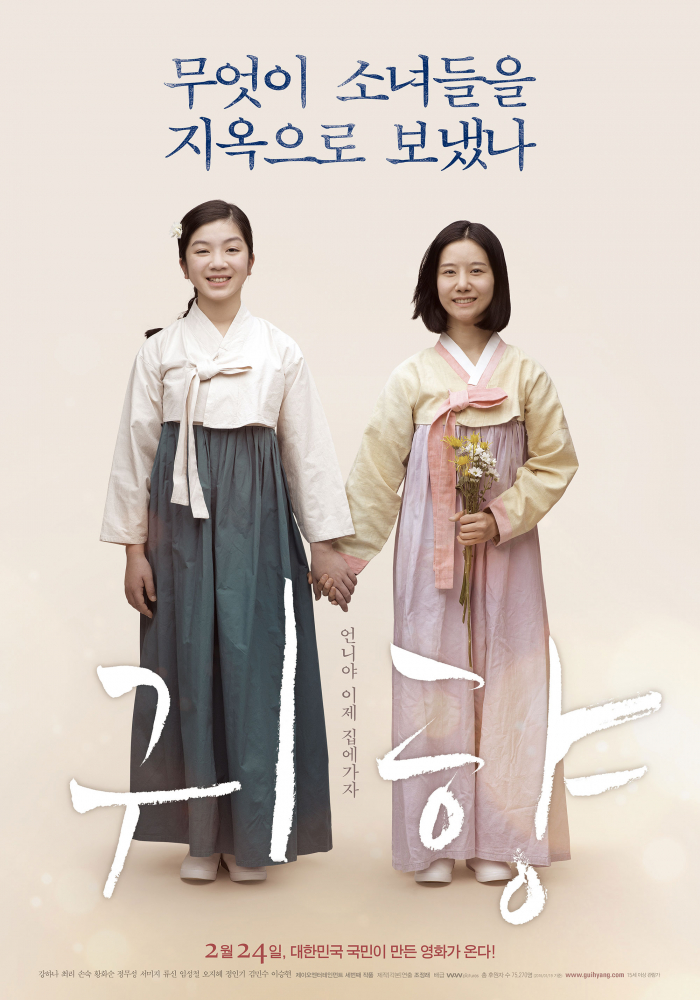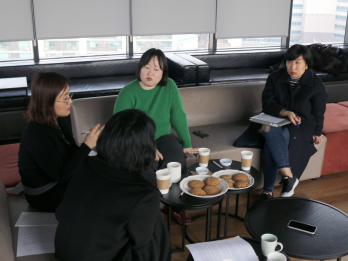Now/here, the inside and outside of the 'comfort women' films, Part 1
<Spirits' Homecoming> as a ‘male-oriented movie'
The era of male-oriented films and the films on 'comfort women'
Since the 2000s, South Korean movies have been focusing on male-dominated narratives mostly centered on male characters. Criticisms towards this trend grew stronger by 2015, and perhaps the popularity of the 'Bechdel test' was an example that thoroughly reflected the public’s discontent towards South Korean films that had been alienating female characters thus far. This gender equality index test, designed by an American cartoonist Alison Bechdel, questions if a movie: "1. has at least two named women in it; 2. who talk to each other; 3. about something besides a man." In fact, passing the Bechdel test does not make a movie a ‘woman’s film’, but the test has been discussed as a meaningful standard for the public, given that even applying this level of test to the current 21st century South Korean films seems to be a tricky challenge.
Meanwhile, in 2017, <I Can Speak> (2017) was the only movie that passed the Bechdel test among the top 15 highest grossing South Korean films. This is worth examining, because over the past three years, films addressing the 'comfort women' issue were particularly dominant among the so-called woman’s films that drew attention or became box office hits. <Spirits' Homecoming> (2016) achieved remarkable box office success through explosive support from the public. Produced as a KBS special drama and re-edited into a movie, <Snowy Road> (2017) did not receive that much public attention, but it continued to be discussed among critics (Son Hee-jung, Kwon Myung-ah, Kwon Eun-sun, and Joo Yu-shin, etc.) as a movie worth watching by being comparable to <Spirits' Homecoming>. <I Can Speak> (2017) became a solid commercial hit attracting the public’s interest in female artist Na Moon-hee, while <Herstory> (2018) created the birth of a loyal fandom, 'Herstorian'. So, why are such 'comfort women' narratives especially receiving great attention among all other women's narratives, despite the fact that men's stories still have dominance over the imagination of women's stories in South Korean films? This was slightly unusual in a sense that the 'comfort women' issue had previously never been a hot topic that received that much attention in South Korean films.
This article addresses the aforementioned question by dedicating the next two parts to examining the inside and outside of the 'comfort women' films recently introduced to the South Korean public, ranging from <Spirits' Homecoming> to <Herstory>. It is very interesting to note that each movie not only illustrated the different reenactment of 'comfort women' but also met with the audience in differing contexts, and created distinct semantic networks. Here, the 'inside' means the matters related to the narratives and images, while the 'outside' means the social contexts surrounding the films and characteristics of the audience. Of course, those 'inside' and 'outside' are tightly interconnected to each other like the Möbius strip.
The popularity of <Spirits' Homecoming> and the context of 『Comfort Women of the Empire』
In 2016, the 'comfort women' issue emerged as the center of public attention again. Specifically, the publication and subsequent controversy over Park Yu-ha's 『Comfort Women of the Empire』2 in 2015 coincided with the irreversible South Korea-Japan Agreement declared in haste on December 28, 2015, and <Spirits' Homecoming> was released amid this atmosphere, which was a movie that completely discredited those two affairs. There were heated debates surrounding <Spirits' Homecoming>. One side criticized this movie for fashioning rape into a visual spectacle thereby treating pain as a subject of pleasure, while the other side insisted on understanding the dynamics of the emotions triggered by this movie and their political meanings. Especially, as 『Comfort Women of the Empire』 was distorting the ‘comfort women’ issue and history, the resistance against colonial rule and its violence presented in <Spirits' Homecoming> as the popular narrative directly contradicting such distortions were highly significant for those advocating this movie. Therefore, in order to understand the enthusiasm for <Spirits' Homecoming>, it is necessary to also examine the problem of the 『Comfort Women of the Empire』, which was one of the social contexts in which the movie was communicated.
What then were the differences between 『Comfort Women of the Empire』 and <Spirits' Homecoming>? Whereas the former emphasized the voluntary nature of the recruitment process among the ‘comfort women’ victims, the latter claimed that the 'comfort women' issue should be approached in terms of sexual slavery. 『Comfort Women of the Empire』 reiterated that the violence or suffering experienced by Korean 'comfort women' were the problems of the patriarchal system mutually shared by imperial Japan and colonial Korea, and therefore had no 'direct' relationship with the rule of the empire. The book further argued that those who 'directly' assaulted 'comfort women' were actually their parents who sold them away, or the Korean pimps who had recruited and trafficked them. Thus, according to the book's explanation, the 'comfort women' system was an extension of the 'Karayuki-San' tradition in which poor women engaged in prostitution for their families, and the circumstances of Korean women at the time were no different from that of Japanese prostitutes.
The argument for the homogeneity between Korean 'comfort women' and Japanese 'comfort women' leads to a focus on the differences between Chinese and Korean women. That is, Korean women were protected as 'companions and colleagues' with mutual affection for male Japanese soldiers, while Chinese women became the real victims of rape and violence by male Japanese soldiers. This was the imagination of 'comradeship' invoked in 『Comfort Women of the Empire』, and the ingredients of this imagination were the memories about the volition involved in the recruitment process and the 'joyous times' found in the oral statements of the 'comfort women' victims. 『Comfort Women of the Empire』 proclaims that the nationalistic reasoning system entangled with the South Korean patriarchal system and the subsequent 'violent movement' based on this had to trap the 'comfort women' victims into the image of the 'pure girl', which ultimately erased the aforementioned memories.
『Comfort Women of the Empire』 falsely exonerates the operational mechanism of Japanese imperialism which relies on patriarchal militarism, while superficially challenging only the patriarchal system as the universal gender system. The subtitle of this book is "Struggle with Colonial Rule and its Memory". The author seemed to be trying to restore the 'women's memories' that had disappeared from public records by “naming memories as 'the arena of struggle for hegemony'”. Nevertheless, by excusing imperialism, which was based on the patriarchal system, the author actually replaced women's memories with 'rewriting the history' that serves and reclaims the patriarchal system. In order to approach the 'comfort women' issue from a feminism perspective, the book ought to have explored how imperialism, militarism, nationalism, and racism in Japan and the Joseon / South Korea intersected with the patriarchal system, instead of leading to an argument that "the patriarchal system is the fundamental system of governance that surpasses imperialism, militarism, nationalism, or racism." The timing of this book's release was extraordinary in a way, since by coinciding and thereby ‘collaborating’ with the diplomatic and political incident of the irreversible South Korea-Japan Agreement on December 28, the book successfully raised public awareness on the distorted history associated with the 'comfort women' issue.

Captivated by violence, the public becomes gendered into men
In contrast to 『Comfort Women of the Empire』, <Spirits' Homecoming> guided the audience to understand the 'comfort women' mobilization system in terms of sexual slavery while being sensitively aware of the universal patriarchal violence against women. The movie combined the universality and peculiarity of the patriarchal system together while understanding the collusion between the patriarchal system and imperialism. This is best illustrated in the scene where Eun-kyung (Choi Ri), a young medium who lives in the present, becomes possessed by spirits. After Eun-kyung is sexually assaulted by an unknown man, Eun-kyung's father attacks the assailant, and a fight ensues between the two men, resulting in both men dying on Eun-kyung's body. Since Eun-kyung is a victim of a general sexual assault, she becomes a medium who can represent the voices of the 'comfort women' who fell victim to the Japanese imperial patriarchal system. The movie’s director expressed at one interview that by taking the role of a sex offender himself for the scene, he wanted to atone for being a man who has the desire that had enabled the 'comfort women' system. This was also a confession about his position as a ‘potential perpetrator’.
However, the director's confession simultaneously normalizes that 'desire' while rather providing an excuse for the comfort station system. Also, as the director's attitude permeates the whole movie, audiences adopt a cinematic viewpoint of being 'men who feel sorry for failing to protect', and by following this viewpoint, the audiences also become gendered as men (although such genderization is not always successful). Here, one might then have an urge to actively question the popularity of <Spirits' Homecoming>. The popularity that led so many people to become immersed in and be enthusiastic about <Spirits' Homecoming> laid on the sensationalism manifested by the movie's 'male-centered patriarchal narrative-image’ (Kwon Eun-sun). By treating a woman's body and rape as a form of spectacle and by fetishizing the pain caused by the victimization, the movie sutures the audience into the screen.
Of course, the excuse for masculine sensationalism is already embedded in the movie’s texts. That is, the movie is simply being loyal to ‘realistic descriptions’ because it is based on the testimonies of the 'comfort women' victims and their works from art therapy. However, which story to choose from among the vast array of testimony is not necessarily predetermined. A rape scene is neither essential in illustrating the process of sexual slavery, and nor does it even absolutely represent 'the most painful moment'. The reason why the scene holds such importance is that the way this society understands the pain of the 'comfort women' victims is fixated on the notion of direct sexual violence.
In this sense, it becomes unclear whether the movie is about the 'comfort women' victims or about the narcissism of 'men who feel sorry for failing to protect'. This suspicion becomes stronger when one watches <Spirits' Homecoming, Unfinished Story> (2018, hereinafter <Spirits' Homecoming 2>), a sequel of <Spirits' Homecoming>.
<Spirits' Homecoming 2> is a cross-edited work that joins the colored images of <Spirits' Homecoming> with the black-and-white images of an actor who starred in <Spirits' Homecoming> preparing a chorus for the 'comfort women' victims. As the black-and-white images depicting the present time do not actually convey any value in terms of narrative significance, <Spirits' Homecoming 2> is nothing more than a rehash of <Spirits' Homecoming>. In other words, the movie is merely a remake that relies on the success of the previous work. The problem, however, is not about self-replication through remakes. The real problem lies in the director's narcissism which compelled him to create such a remake. The director places the voice-over oral narration of the 'comfort women' victims while playing 'the first group rape sequence at the comfort station' which was the most criticized part in <Spirits' Homecoming>. In other words, the director placed the victim's voice directly over the scene to reiterate, "My movie is justified because it is reenacting what was said in the victim's testimony." Here, the victim's voice degenerates into an excuse to guarantee the justification of the director. Also, in order to distinguish between the images of reenactment from <Spirits' Homecoming> and the images of the recording from the present times, <Spirits' Homecoming 2> even makes the records of the 'comfort women' victim's oral narration images black and white, devoid of any color. To make it easy for the audience to distinguish the nature of those two footages, the recorded images are strictly treated as dead and rigid to function as instruments.
By the time one watches <Spirits' Homecoming 2>, the answer to the doubt "Was <Spirits' Homecoming> a woman’s film, after all?" becomes clear. It would be accurate to regard <Spirits' Homecoming> not as a ‘woman’s film' but rather a ‘male-oriented film' in which men's stories were expressed through women's victim narratives while appealing to the audience who became gendered into men.
This article will continue in Part 2.
Related contents
-

- Now/here, the inside and outside of the 'comfort women'1 films, Part 2 - It is possible to imagine differently
-
Written by Son Hee-jung, Yonsei University Institute of Gender Studies
-

- 대중매체를 통해 바라본 일본군‘위안부’의 재현 〈1부〉 - 〈여명의 눈동자〉부터 〈허스토리〉까지, 대중매체를 통해 바라본 일본군‘위안부’ 역사의 재현전략
-
사회 : 허윤(부산외대 만오교양대학 교수) 패널 : 권은선(중부대 연극영화과, 영화평론가) / 오혜진(한예종, 문학평론가) / 김청강(한양대 연극영화학과 교수)
-

- 대중매체를 통해 바라본 일본군‘위안부’의 재현 〈2부〉 - '위안부'를 둘러싼 재현의 윤리, 어디까지 묘사하고 재현할 것인가
-
‘위안부'를 둘러싼 재현의 윤리, 어디까지 묘사하고 재현할 것인가
-

- 대중매체를 통해 바라본 일본군‘위안부’의 재현 〈3부〉 - 재현물로서 〈허스토리〉의 성공과 실패
-
재현물로서 <허스토리>의 성공과 실패
- Writer Son Hee-jung
-
Yonsei University Institute of Gender Studies, Researcher.
jay.sohn@icloud.com